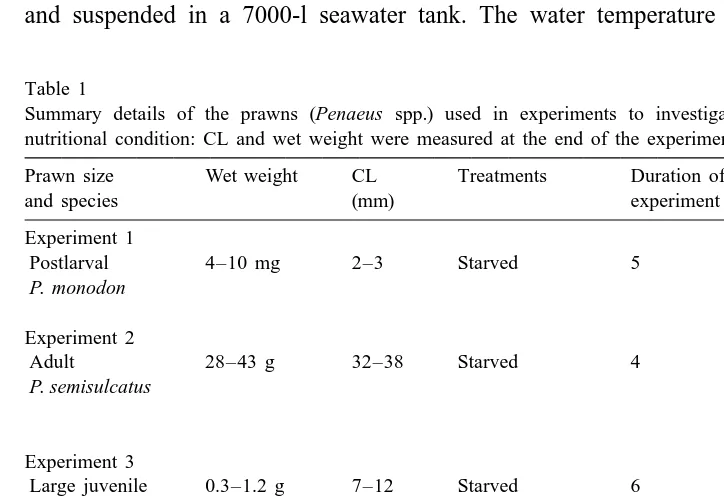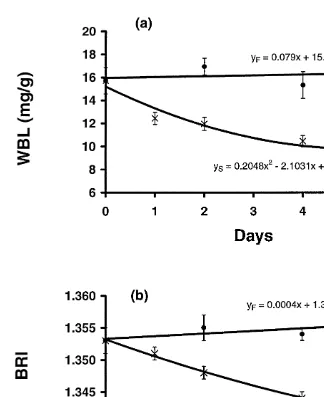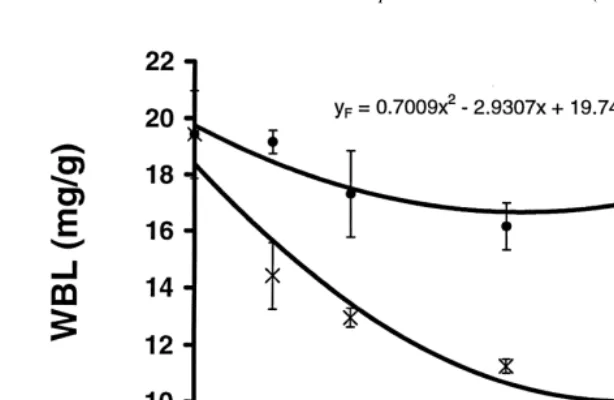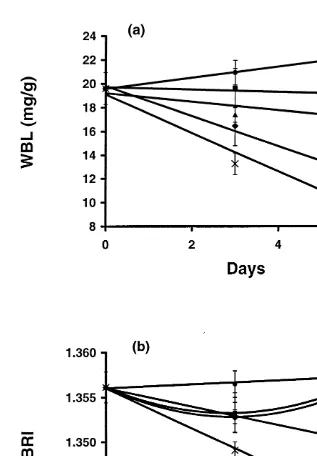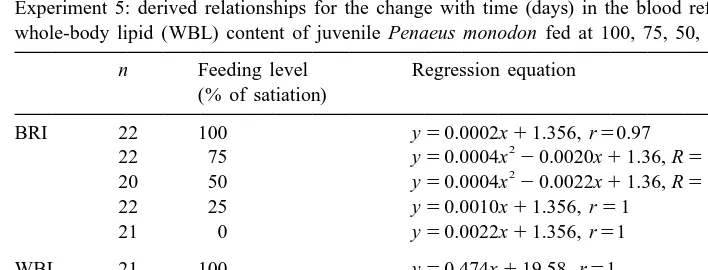L
Journal of Experimental Marine Biology and Ecology 244 (2000) 131–143
www.elsevier.nl / locate / jembe
Blood refractive index and whole-body lipid content as
indicators of nutritional condition for penaeid prawns
(Decapoda: Penaeidae)
*
L.E. Moore, D.M. Smith , N.R. Loneragan
CSIRO Marine Laboratories, P.O. Box 120, Cleveland, Qld 4163, Australia Received 9 June 1999; received in revised form 21 July 1999; accepted 26 August 1999
Abstract
To assess potential indices of nutritional condition, we examined changes in lipid content and the blood refractive index (BRI) of postlarval, juvenile and adult prawns (Penaeus spp.) that had been starved or fed to different levels of satiation. The whole-body lipid content (WBL) of small juvenile P. esculentus (20–120 mg wet weight) decreased significantly after 12 h of starvation. The WBL of postlarval P. monodon (4–10 mg wet weight) also decreased during starvation, with WBL almost halving after 5 days. Juvenile P. monodon (0.5–1.3 g wet weight) fed at 25 or 50% of the satiation ration for 6 days had significantly lower WBL than satiated prawns. The lowest concentrations of WBL were recorded for starved prawns and those fed to 25% of satiation. In larger juvenile P. semisulcatus (0.3–1.2 g wet weight) the WBL was also sensitive to starvation, declining significantly after only 1 day. The blood lipid content and digestive gland lipid of adult P. semisulcatus (28–43 g wet weight) decreased significantly after 4 days of starvation. The BRI of starved prawns and those fed to satiation correlated well with the WBL in the case of smaller prawns (r.0.96) and with the blood lipid of adult P. semisulcatus (28–43 g wet weight). However, there was a weaker correlation between BRI and WBL in prawns whose feed allocations were between starvation and satiation (r50.86). These results from several prawn species and different size classes show that both the BRI and WBL have potential as indices of nutritional condition. Although BRI is much easier and cheaper to measure than WBL and can be measured in the field, it is suitable only for prawns from which sufficient blood can be obtained — generally those larger than 300 mg wet weight (7 mm carapace length). In contrast, WBL can be measured with a good level of precision in individual prawns as small as 20 mg wet weight (3 mm carapace length) using relatively simple laboratory equipment. 2000 Elsevier Science B.V. All rights reserved.
Keywords: Penaeus esculentus; Penaeus monodon; Penaeus semisulcatus; Shrimp
*Corresponding author. Tel.: 161-7-3826-7200; fax: 161-7-3826-7222.
E-mail address: [email protected] (D.M. Smith)
1. Introduction
A simple, easy-to-use index of condition would be valuable for studies of both the ecology and aquaculture of prawns. The nutritional condition of a prawn is the extent to which it has accumulated reserves of nutrients to allow normal physiological function and growth. The most important and quantifiable of these reserves are its energy and protein content. The nutritional condition of a prawn population in a particular habitat could indicate whether the quality or quantity of food is limiting growth and survival, and perhaps explain the timing of emigration of prawn populations from their nursery habitats. Similarly, a field procedure for assessing the nutritional condition of prawns would be useful for monitoring the effects of restocking or enhancing prawn populations in natural seagrass beds; or for assessing the condition of the broodstock and the health and vigour of juvenile prawns in aquaculture hatcheries or ponds.
The nutritional condition of a vertebrate can be assessed from its external appearance. However, this is not the case for crustaceans: their external dimensions are more or less fixed at each moult. For example, even though body weight and volume decrease slightly during starvation, these changes are difficult to detect in the brown tiger prawn (Penaeus esculentus) until after 2 or 3 weeks of starvation, because the metabolised tissues are replaced by water (Barclay et al., 1983; Dall and Smith, 1987). A useful nutritional condition index for crustaceans should show a response to sub-satiation or starvation in a much shorter period.
Indices of nutritional condition that have been advocated for crustaceans include whole-body lipid content (WBL) (Barclay et al., 1983), size of triacylglycerol reserves
˚
(Fraser, 1989; Bamstedt et al., 1990), ratio of triacylglycerol to total polar lipid (Mourente and Rodriguez, 1997), the ratio of RNA to DNA (Wang and Stickle, 1986; Bulow, 1987; Moss, 1994) and enzyme activity (Clarke and Walsh, 1993). However, some of these methods require sophisticated laboratory facilities that are rarely available on aquaculture farms or in remote field locations, and hence are not practical for assessing the nutritional condition of prawns in these places.
A possible index of nutritional condition is the concentration of protein in the blood, which decreases in starved prawns and lobsters. This decrease is mostly due to a dilution effect caused by an increase in blood volume that occurs when muscle tissue metabolises during starvation (Dall, 1974; Smith and Dall, 1982; Depledge and Bjerregaard, 1989). The concentration of protein in the blood is directly proportional to the refractive index of the blood, which is very easily measured with a serum refractometer (Smith and Dall, 1982). Measurements of the blood refractive index (BRI) therefore offer potential as a field method for assessing the nutritional condition of prawns.
2. Materials and methods
Five experiments were carried out on three species of penaeid prawn in size classes from postlarva to adult (Table 1). The first two experiments were preliminary studies (Table 1) to obtain an indication of the magnitude of the response to several days of starvation. Then two more rigorously controlled experiments were carried out to measure the effects of starvation in juvenile prawns (Table 1). In the final experiment, feed was rationed relative to the intake of the control group, which was fed to satiation, to assess the sensitivity of both the response of the animals and the measuring techniques that were used (Table 1).
2.1. Preliminary experiments — postlarva P. monodon and adult P. semisulcatus
In Experiment 1, about 100 postlarval P. monodon between 4 and 10 mg wet weight (2–3 mm carapace length, CL) were obtained from a prawn hatchery in mid-summer. They were kept in a 39035803300 mm plastic mesh basket lined with 2-mm mesh and suspended in a 7000-l seawater tank. The water temperature was maintained at
Table 1
Summary details of the prawns (Penaeus spp.) used in experiments to investigate potential indices of a
nutritional condition: CL and wet weight were measured at the end of the experiment
Prawn size Wet weight CL Treatments Duration of NC
and species (mm) experiment (days) Parameters
Experiment 1
Postlarval 4–10 mg 2–3 Starved 5 WBL
P. monodon
Experiment 2
Adult 28–43 g 32–38 Starved 4 BRI
P. semisulcatus Blood lipid
DGL Experiment 3
Large juvenile 0.3–1.2 g 7–12 Starved 6 WBL
P. semisulcatus or fed BRI
Experiment 4
Small juvenile 20–120 mg 3–6 Starved 3.5 WBL
P. esculentus or fed
Experiment 5
Large juvenile 0.5–1.3 g 10–14 Starved or 6 WBL
P. monodon fed at 25, BRI
50, 75 and 100% satiation a
28618C. The prawns were starved for 5 days. About 15 prawns were taken from the basket and frozen on their arrival at the laboratory (0 day sample). Similar samples of seven prawns were taken at 24-h intervals for 5 days for analysis of WBL content.
In Experiment 2, 16 adult male P. semisulcatus (28–43 g; 32–38 mm CL) trawled from the Gulf of Carpentaria, Australia (128409S, 1418409E) were placed in a 10 000-l tank at the Cleveland laboratory. They were fed to excess on a diet of fresh, frozen invertebrates (squid, Loligo sp.; mussel, Perna canaliculus; and prawn, Metapenaeus bennettae) for 8 weeks, until the start (day 0) of the starvation experiment. On each of days 0, 2 and 4 after the cessation of feeding, a sample of five or six prawns in intermoult stage was taken. The moult stage, wet weight and CL of each prawn were recorded. The BRI, blood lipid content and digestive gland lipid content of these prawns were determined.
2.2. Experiment 3 — juvenile P. semisulcatus
About 100 juvenile P. semisulcatus of 6–8 mm CL were trawled from the Embley River, Gulf of Carpentaria, Australia (128429S, 1418539E) in early summer and flown to the Cleveland laboratory. They were placed in two 300-l tanks and acclimatised to laboratory conditions for 12 days. During this time, they were fed to excess a commercial prawn feed formulated for P. japonicus; small pieces of fresh, frozen prawn muscle (M. bennettae), and a natural food supplement (see below).
The natural food supplement comprised strips of shade-cloth, 5003200 mm deep, that had been suspended in an outdoor, 300-l tank. The tanks, which had been inoculated with about 9 l of mud and seagrass obtained from a nearby seagrass bed, contained large numbers of microbenthic organisms, including amphipods and copepods. The tank was provided with a constant flow of seawater (23–278C) and fertilised weekly with a
slow-release fertiliser (125 g of Osmocote , Scotts-Sierra Horticultural Products) to maintain an active culture of micro- and macro-algae. After 3 weeks the shade-cloth was covered with epiphitic algae and had been colonised by a variety of small invertebrates. Strips of shade-cloth, 503200 mm deep, were cut from the sheets in the outdoor tank and suspended in each prawn tank or cage to provide a natural food supplement. These were replaced every second day as the biota was grazed down.
After the acclimatisation period, the prawns were placed individually in cylindrical cages (250 mm high3150 mm diameter) of 6-mm polyethylene mesh with a solid PVC cap and a removable 390-mm mesh base underneath the polyethylene mesh base. Eleven cages were placed in each of six 300-l tanks. Throughout the experiment, the flow rate of seawater through the tanks was kept at 1.7 l / min, and the water temperature was maintained at 28618C.
2.3. Experiment 4 — Juvenile P. esculentus
About 150 small juvenile P. esculentus of 2–3 mm CL were trawled from the Embley River, and flown to the Cleveland laboratory. Eighty prawns were placed individually in 400-ml beakers full of seawater and covered with cotton netting. The prawns were kept in a temperature-controlled room to maintain the water in the beakers at 28618C.
Prawns were fed to excess on a mixture of Fripak 3001ultra postlarval feed, fresh diatoms (Chaetoceros muelleri ) and live brine shrimp (Artemia salina). The water in the beakers was changed daily.
After 3 weeks, the prawns had grown to between 3 and 6 mm CL. Five randomly selected prawns were taken for the day 0 sample. Half of the remaining prawns continued to be fed as before and the others were starved. At 12-h intervals thereafter until 84 h, five fed and five starved prawns were sampled: individuals were weighed and measured, then placed in glass vials and frozen at 2508C for WBL determination. The BRI was not measured because sufficient blood cannot be drawn from these prawns to give a reliable reading on the serum refractometer (Atago Optical Works).
2.4. Experiment 5 — juvenile P. monodon
About 7000 13-day-old postlarval P. monodon were flown from Great Barrier Reef Marine Hatchery, Bingil Bay, Australia to the Cleveland laboratory in late summer. They were fed initially on diatoms (C. muelleri), live brine shrimp (A. salina) and Fripak 3001ultra postlarval feed. As they grew larger their diet was gradually changed over to commercial prawn feeds, initially a crumble (1.0 mm diameter) formulated for P. japonicus, and then a starter diet (1.5 mm diameter) formulated for P. monodon. After 4 weeks at the laboratory, 80 prawns (0.39–0.86 g) were placed individually in the cages described in Section 2.2. Sixteen cages were placed in each of six 300-l tanks. Seawater flowed through the tanks at 1.7 l / min, and the water temperature was maintained at 28618C throughout the experiment.
The caged prawns were fed to satiation once daily on P. monodon starter diet. For the first 8 days, each individual’s feed intake was closely monitored and the feed ration adjusted to determine the satiation amount. After 8 days in the cages, seven prawns were selected randomly for the initial sample (day 0). On day 1, groups of prawns were either fed to satiation, starved (0% treatment) or fed proportions of the satiation ration (25, 50 and 75%). On days 3 and 6, seven or eight prawns were randomly selected from each treatment and their wet weight, CL and BRI were measured, and the WBL in each prawn was determined.
2.5. Measurements and analyses
A sample of blood, between 10 and 700ml, depending on the size of the prawn, was taken from the pericardial sinus with a disposable 1-ml syringe fitted with a 0.4313 mm needle. The BRI was measured immediately after the sample was taken, using a clinical serum refractometer (Atago Optical Works). A 3% sodium chloride solution was used as a reference, with its refraction edge adjusted to the 1.334 graduation on the refractive index scale. Where the blood lipid was to be determined, the remainder of the blood sample was frozen at 2508C until analysed.
Lipids were extracted from individual whole postlarva and juvenile prawns and from the blood and digestive gland of adult prawns in chloroform–methanol (2:1, v / v) (Folch et al., 1957). The weight of lipid in the extract was determined gravimetrically to the nearest 0.01 mg on a microbalance. The WBL or digestive gland lipid content of each prawn were expressed as milligrams of lipid per gram wet weight of prawn (mg / g), while the lipid content of blood in adult prawns was expressed as milligrams of lipid per millilitre of blood (mg / ml).
2.6. Data analysis
For experiments 1 and 2, the means and standard errors of each parameter were calculated for each period of starvation. A one-way analysis of variance was used to detect significant differences between the treatments (period of starvation) for each of the parameters, and contrasts were made between all possible pairs of treatments. For experiments 3, 4 and 5, the means and standard errors of each parameter (BRI and / or WBL) for each treatment (feeding level) were plotted against time, and the relationship between the parameter and time was examined by using linear or quadratic models for each treatment. The slopes of the lines were tested to see whether they differed significantly from zero. Paired t-tests were also used to test for differences in the parameters between treatments at each sampling time of the experiment. Correlations between BRI and WBL of fed and starved prawns and of prawns fed between satiation and starvation (Experiment 5) were determined.
3. Results
3.1. Preliminary experiments — postlarval P. monodon and adult P. semisulcatus
In Experiment 1, the mean WBL of postlarval P. monodon on day 0 was 9.460.5 mg / g. The WBL decreased significantly (P,0.05) to 7.460.5 mg / g after 1 day of starvation and continued to decline to 5.560.4 mg / g after 5 days.
Table 2
Mean values (6SE) for blood refractive index (BRI), the lipid content of blood (blood lipid) and the digestive gland lipid content (DGL) of adult Penaeus semisulcatus (28–43 g wet weight) starved for different periods in
a
Within response criteria, means with the same superscript do not differ significantly (P.0.05). DGL, digestive gland lipid.
3.2. Feeding and starvation experiments — juvenile P. semisulcatus and P. esculentus
The BRI and WBL of the control (fed) juvenile P. semisulcatus increased slightly but not significantly (P.0.05) over the 6 days of the study in Experiment 3 (Fig. 1). In contrast, both the BRI and WBL values of starved prawns declined significantly over time. This decline for both BRI and WBL was best described by a quadratic equation, having a sharp decline from day 0 to day 1, and a lesser decline after day 1 (Fig. 1). The WBL of fed juvenile P. esculentus in Experiment 4 decreased slightly but not significantly (P.0.05) over 3.5 days (Fig. 2). However, the WBL of starved prawns decreased markedly with time, with a significant difference between fed and starved prawn after 12 h.
3.3. Graded feeding experiment — juvenile P. monodon (0.5 –1.3 g wet weight)
WBL of prawns fed to satiation (100%) in Experiment 5 increased slightly with time, whereas that of prawns fed less than satiation showed a very consistent decrease with time and with level of satiation (Table 3, Fig. 3). Similarly, the BRI of prawns fed to satiation was relatively constant over 6 days, while that of prawns starved (0%) or fed to 25% satiation decreased consistently with time and level of satiation. However, the BRI of prawns fed to 50 and 75% satiation initially decreased, but by day 6 had returned to levels similar to that of fed prawns (Table 3, Fig. 3).
4. Discussion
Fig. 1. Change mean (6SE) of whole-body lipid (WBL) content (a) and in mean (6SE) of blood refractive index (b) of fed (d, Y ) and starved (F 3, Y ) juvenile Penaeus semisulcatus over 4 days.S
sub-adult P. esculentus (14–24 g) decreased by 43% after 18 days of starvation (Barclay et al., 1983). In the present study the WBL of larger (4–10 mg) postlarval P. monodon decreased by 41% after 5 days of starvation. The WBL of juvenile P. monodon, P. esculentus and P. semisulcatus declined by between 38 and 50% over 4–6 days of starvation, and that of adult prawns decreased by about 50% over 5 days. Our results are consistent with previously published work but also demonstrate a very strong relation-ship between feeding level and WBL of juvenile P. monodon (Fig. 3).
Fig. 2. Change in mean (6SE) of whole-body lipid (WBL) content of fed (d, Y ) and starved (F 3, Y )S juvenile Penaeus esculentus over 4 days.
proportional to feeding level (Fig. 3). The prawns fed to satiation showed a slight increase in WBL, while those fed at specific proportions of the satiation-feeding ration showed a decline in WBL that was consistent with the feeding rate. This demonstrates that the WBL is a sensitive indicator of nutritional condition and recent feeding history. After a prolonged period of sub-satiation feeding, such as the period between successive moults, the WBL of the prawns fed at 75 and 50% of their satiation ration would probably be depleted to a minimum threshold level. The minimum WBL concentrations recorded for starved juvenile P. semisulcatus, P. esculentus, and P. monodon were similar; attaining 9.8, 9.7 and 9.9 mg / g, respectively, with small standard errors. These results suggest that the threshold value of WBL for juvenile penaeid prawns may be about 9.8 mg / g. At this point, it is probable that catabolism of muscle protein could increase (Smith and Dall, 1982), resulting in an increase in blood volume and causing a decline in BRI due to dilution of the blood proteins. The WBL of prawns fed 75 and 50% of their satiation ration had not reached this minimum at the end of our experiment. Further sub-satiation experiments of longer duration are needed to confirm that the WBL had reached a minimum level, and to establish the length of time before BRI begins to decrease in prawns fed at these levels.
Fig. 3. Change in mean (6SE) of whole-body lipid content (WBL) (a) and blood refractive index (BRI) (b) of juvenile Penaeus monodon fed at 100% (d), 75% (j), 50% (m), 25% (♦) and 0% (3) of satiation.
Table 3
Experiment 5: derived relationships for the change with time (days) in the blood refractive index (BRI) and whole-body lipid (WBL) content of juvenile Penaeus monodon fed at 100, 75, 50, 25 and 0% of satiation
n Feeding level Regression equation
study the BRI of starved adult P. semisulcatus of similar size (28–43 g) decreased by an average of 0.001 / day.
The WBL and BRI methods (Figs. 1 and 3) recorded similar responses to periods of starvation; they were strongly correlated (r.0.96). However, where the prawns were fed below satiation, but not totally starved, there appeared to be a lower response of the BRI over the periods studied (Fig. 3) with weaker correlation between the BRI and WBL (r50.86). These results suggest that BRI may be a less sensitive index of nutritional condition than WBL. The BRI of starved juvenile P. semisulcatus decreased significantly after 2 days of starvation, whereas the WBL decreased significantly after only 1 day of starvation. The WBL of small juvenile P. esculentus had decreased significantly after only 12 h of starvation (Fig. 2). Furthermore, the BRI of juvenile P. monodon fed at 50% of their satiation ration for 6 days did not differ significantly from that of prawns fed to satiation, whereas their WBL was significantly lower than that of the satiated prawns. It should also be noted that juvenile prawns were found to respond to starvation more quickly than adult prawns. The BRI of juvenile P. semisulcatus declined markedly after only 2 days of starvation (Fig. 1), while that of adult P. semisulcatus declined more slowly (Table 2).
The BRI response of prawns that were starved or fed at 25% satiation was linear (Table 3, Fig. 3). In contrast, the response of prawns that were fed at 50 and 75% satiation was markedly curvilinear. With 75 and 50% satiation feeding, over the first 3 days the BRI decreased because of either a depletion in certain blood proteins or an increase in blood volume (Smith and Dall, 1982). However, thereafter it appeared that these prawns were able to regulate the blood protein concentration. This regulation could be a result of the production of more blood proteins or a reduction in blood volume; the net result is a return of BRI to the initial levels. The results also showed that prawns with an intake of less than 50% of satiation were unable to regulate the blood protein concentration in a similar manner.
wet weight (7 mm CL). In contrast, the WBL of prawns as small as 20 mg wet weight (3 mm CL) could be measured with a good level of precision; it was less reliable for smaller prawns as it was too close to the detection limit of our weighing procedure and microbalance.
5. Conclusions
The results of these studies from three species of penaeid prawns at different stages of their life history demonstrate that BRI and WBL have considerable potential as nutritional indices of prawns. When comparing the nutritional condition of prawns from different habitats or different culture conditions the prawns must be of similar size, as small prawns respond more quickly to changes in feed intake than large prawns.
The serum refractometer used to measure BRI is a simple, small instrument that can be used in the field or on prawn farms. The BRI method would be useful for measuring the nutritional condition of prawns in field locations, but is limited to prawns over 300 mg wet weight (7 mm CL). The WBL method requires the use of laboratory facilities, but provides a more sensitive assessment and can be used for small juvenile prawns of 20 mg wet weight through to adult prawns, though with adult prawns the analysis of the digestive gland lipid may be more practical.
Acknowledgements
Margaret Barclay helped with lipid extractions. Yougan Wang advised on statistical analysis. William Dall and Kevin Williams provided helpful comments on the manu-scripts. This work was funded by the Fisheries Research and Development Corporation grants 92 / 45 and 92 / 51, and the Aquaculture and Biotechnology Program of CSIRO Marine Research. [SS]
References
˚ ˚ ¨
Bamstedt, U., Hakanson, J.L., Brenner-Larsen, J., Bjoernsen, P.K., Geertz-Hansen, O., Tiselius, P., 1990. Copepod nutritional condition and pelagic production during autumn in Kosterfjorden, Western Sweden. Mar. Biol. 104, 197–208.
Barclay, M.C., Dall, W., Smith, D.M., 1983. Changes in lipid and protein during starvation and the moulting cycle in the tiger prawn, Penaeus esculentus Haswell. J. Exp. Mar. Biol. Ecol. 68, 229–244.
Bulow, F.J., 1987. RNA–DNA ratios as indicators of growth in fish: a review. In: Summerfelt, R.C., Hall, G.E. (Eds.), Age and Growth in Fish, Iowa State University Press, Ames, pp. 45–64.
Busselen, P., 1970. Effects of moulting cycle and nutritional condition on haemolymph proteins in Carcinus
maenas. Comp. Biochem. Physiol. 37, 73–83.
Chandumpai, A., Dall, W., Smith, D.M., 1991. Lipid-class composition of organs and tissues of the tiger prawn
Penaeus esculentus during the moulting cycle and during starvation. Mar. Biol. 108, 235–245.
Clarke, M.E., Walsh, P.J., 1993. Effect of nutritional status on citrate synthetase activity in Acartia tonsa and
Dall, W., 1974. Indices of nutritional state in the western rock lobster, Panulirus longipes (Milne Edwards). I. Blood and tissue constituents and water content. J. Exp. Mar. Biol. Ecol. 16, 167–180.
Dall, W., Smith, D.M., 1987. Changes in protein-bound and free amino acids in the muscle of the tiger prawn
Penaeus esculentus during starvation. Mar. Biol. 95, 509–520.
Dall, W., Chandumpai, A., Smith, D.M., 1992. Fatty acid composition of organs and tissues of the tiger prawn
Penaeus esculentus during the moulting cycle and during starvation. Mar. Biol. 113, 45–55.
Depledge, M.H., Bjerregaard, P., 1989. Haemolymph protein composition and copper levels in decapod crustaceans. Helgol. Meeresunters. 43, 207–223.
Folch, J., Lees, M., Sloane Stanley, G.H., 1957. A simple method for the isolation and purification of total lipids from animal tissues. J. Biol. Chem. 226, 497–509.
Fraser, A.J., 1989. Triacylglycerol content as a condition index for fish, bivalve, and crustacean larvae. Can. J. Fish. Aquat. Sci. 46, 1868–1873.
Frolov, A.V., Pankov, S.L., 1992. The effect of starvation on the biochemical composition of the rotifer
Brachionus plicatilis. J. Mar. Biol. Assoc. UK 72, 343–356.
Leavitt, D.F., Bayer, R.C., 1977. A refractometric method of determining serum protein concentration in the American lobster. Aquaculture 12, 169–171.
Moss, S.M., 1994. Growth rates, nucleic acid concentrations, and RNA / DNA ratios of juvenile white shrimp,
Penaeus vannamei Boone, fed different algal diets. J. Exp. Mar. Biol. Ecol. 182, 193–204.
Mourente, G., Rodriguez, A., 1997. Effects of salinity and dietary DHA (22:6n-3) content on lipid composition and performance of Penaeus kerathurus postlarvae. Mar. Biol. 128, 289–298.
Smith, D.M., Dall, W., 1982. Blood protein, blood volume and extracellular space relationships in two Penaeus spp. (Decapoda: Crustacea). J. Exp. Mar. Biol. Ecol. 63, 1–15.
Stewart, J.E., Cornick, J.W., Dingle, J.R., 1967. An electronic method for counting lobster (Homarus
americanus Milne Edwards) hemocytes and the influence of diet on hemocyte numbers and hemolymph
proteins. Can. J. Zool. 45, 291–304.
Vogt, G., Storch, V., Quinitio, E.T., Pascual, F.P., 1985. Midgut gland as monitor organ for the nutritional value of diets in Penaeus monodon (Decapoda). Aquaculture 48, 1–12.
Wang, S.Y., Stickle, W.B., 1986. Changes in nucleic acid concentration with starvation in the blue crab
